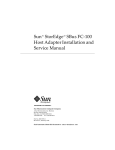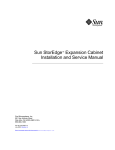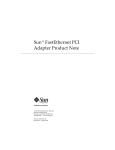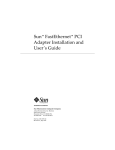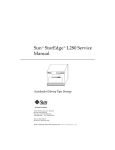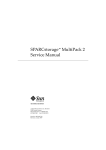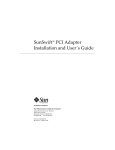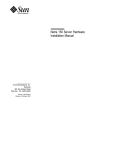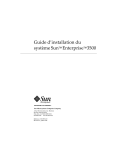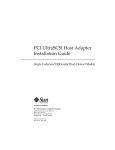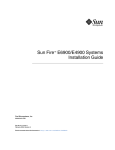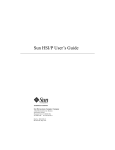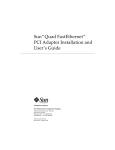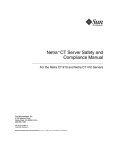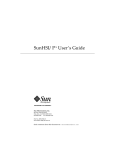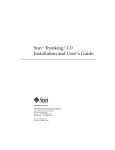Download Sun™ StorEdge™ FC-100 Hub Installation and Service Manual
Transcript
Sun™ StorEdge™ FC-100 Hub Installation and Service Manual Formerly the Sun™ Enterprise Network Array™ Sun Microsystems, Inc. 901 San Antonio Road Palo Alto, CA 94303-4900 USA 650 960-1300 Fax 650 969-9131 Part No. 805-0315-12 September 1998, Revision A Send comments about this document to: [email protected] Copyright 1998 Sun Microsystems, Inc. 901 San Antonio Road • Palo Alto, CA 94303 USA. All rights reserved. This product or document is protected by copyright and distributed under licenses restricting its use, copying, distribution, and decompilation. No part of this product or document may be reproduced in any form by any means without prior written authorization of Sun and its licensors, if any. Third-party software, including font technology, is copyrighted and licensed from Sun suppliers. Parts of the product may be derived from Berkeley BSD systems, licensed from the University of California. UNIX is a registered trademark in the U.S. and other countries, exclusively licensed through X/Open Company, Ltd. Sun, Sun Microsystems, the Sun logo, AnswerBook, Sun StorEdge, Sun Enterprise Network Array and Solaris are trademarks, registered trademarks, or service marks of Sun Microsystems, Inc. in the U.S. and other countries. All SPARC trademarks are used under license and are trademarks or registered trademarks of SPARC International, Inc. in the U.S. and other countries. Products bearing SPARC trademarks are based upon an architecture developed by Sun Microsystems, Inc. The OPEN LOOK and Sun™ Graphical User Interface was developed by Sun Microsystems, Inc. for its users and licensees. Sun acknowledges the pioneering efforts of Xerox in researching and developing the concept of visual or graphical user interfaces for the computer industry. Sun holds a non-exclusive license from Xerox to the Xerox Graphical User Interface, which license also covers Sun’s licensees who implement OPEN LOOK GUIs and otherwise comply with Sun’s written license agreements. RESTRICTED RIGHTS: Use, duplication, or disclosure by the U.S. Government is subject to restrictions of FAR 52.227-14(g)(2)(6/87) and FAR 52.227-19(6/87), or DFAR 252.227-7015(b)(6/95) and DFAR 227.7202-3(a). DOCUMENTATION IS PROVIDED “AS IS” AND ALL EXPRESS OR IMPLIED CONDITIONS, REPRESENTATIONS AND WARRANTIES, INCLUDING ANY IMPLIED WARRANTY OF MERCHANTABILITY, FITNESS FOR A PARTICULAR PURPOSE OR NONINFRINGEMENT, ARE DISCLAIMED, EXCEPT TO THE EXTENT THAT SUCH DISCLAIMERS ARE HELD TO BE LEGALLY INVALID. Copyright 1998 Sun Microsystems, Inc., 901 San Antonio Road • Palo Alto, CA 94303 Etatis-Unis. Tous droits réservés. Ce produit ou document est protégé par un copyright et distribué avec des licences qui en restreignent l’utilisation, la copie, la distribution, et la décompilation. Aucune partie de ce produit ou document ne peut être reproduite sous aucune forme, par quelque moyen que ce soit, sans l’autorisation préalable et écrite de Sun et de ses bailleurs de licence, s’il y en a. Le logiciel détenu par des tiers, et qui comprend la technologie relative aux polices de caractères, est protégé par un copyright et licencié par des fournisseurs de Sun. Des parties de ce produit pourront être dérivées des systèmes Berkeley BSD licenciés par l’Université de Californie. UNIX est une marque déposée aux Etats-Unis et dans d’autres pays et licenciée exclusivement par X/Open Company, Ltd. Sun, Sun Microsystems, le logo Sun, AnswerBook, Sun StorEdge, Sun Enterprise Network Array et Solaris sont des marques de fabrique ou des marques déposées, ou marques de service, de Sun Microsystems, Inc. aux Etats-Unis et dans d’autres pays. Toutes les marques SPARC sont utilisées sous licence et sont des marques de fabrique ou des marques déposées de SPARC International, Inc. aux Etats-Unis et dans d’autres pays. Les produits portant les marques SPARC sont basés sur une architecture développée par Sun Microsystems, Inc. L’interface d’utilisation graphique OPEN LOOK et Sun™ a été développée par Sun Microsystems, Inc. pour ses utilisateurs et licenciés. Sun reconnaît les efforts de pionniers de Xerox pour la recherche et le développement du concept des interfaces d’utilisation visuelle ou graphique pour l’industrie de l’informatique. Sun détient une licence non exclusive de Xerox sur l’interface d’utilisation graphique Xerox, cette licence couvrant également les licenciés de Sun qui mettent en place l’interface d’utilisation graphique OPEN LOOK et qui en outre se conforment aux licences écrites de Sun. CETTE PUBLICATION EST FOURNIE "EN L’ETAT" ET AUCUNE GARANTIE, EXPRESSE OU IMPLICITE, N’EST ACCORDEE, Y COMPRIS DES GARANTIES CONCERNANT LA VALEUR MARCHANDE, L’APTITUDE DE LA PUBLICATION A REPONDRE A UNE UTILISATION PARTICULIERE, OU LE FAIT QU’ELLE NE SOIT PAS CONTREFAISANTE DE PRODUIT DE TIERS. CE DENI DE GARANTIE NE S’APPLIQUERAIT PAS, DANS LA MESURE OU IL SERAIT TENU JURIDIQUEMENT NUL ET NON AVENU. Regulatory Compliance Statements Your Sun product is marked to indicate its compliance class: • • • Federal Communications Commission (FCC) — USA Department of Communications (DOC) — Canada Voluntary Control Council for Interference (VCCI) — Japan Please read the appropriate section that corresponds to the marking on your Sun product before attempting to install the product. FCC Class A Notice This device complies with Part 15 of the FCC Rules. Operation is subject to the following two conditions: 1. This device may not cause harmful interference. 2. This device must accept any interference received, including interference that may cause undesired operation. Note: This equipment has been tested and found to comply with the limits for a Class A digital device, pursuant to Part 15 of the FCC Rules. These limits are designed to provide reasonable protection against harmful interference when the equipment is operated in a commercial environment. This equipment generates, uses and can radiate radio frequency energy and, if not installed and used in accordance with the instruction manual, may cause harmful interference to radio communications. Operation of this equipment in a residential area is likely to cause harmful interference in which case the user will be required to correct the interference at his own expense. Shielded Cables: Connections between the workstation and peripherals must be made using shielded cables in order to maintain compliance with FCC radio frequency emission limits. Networking connections can be made using unshielded twisted-pair (UTP) cables. Modifications: Any modifications made to this device that are not approved by Sun Microsystems, Inc. may void the authority granted to the user by the FCC to operate this equipment. FCC Class B Notice This device complies with Part 15 of the FCC Rules. Operation is subject to the following two conditions: 1. This device may not cause harmful interference. 2. This device must accept any interference received, including interference that may cause undesired operation. Note: This equipment has been tested and found to comply with the limits for a Class B digital device, pursuant to Part 15 of the FCC Rules. These limits are designed to provide reasonable protection against harmful interference in a residential installation. This equipment generates, uses and can radiate radio frequency energy and, if not installed and used in accordance with the instructions, may cause harmful interference to radio communications. However, there is no guarantee that interference will not occur in a particular installation. If this equipment does cause harmful interference to radio or television reception, which can be determined by turning the equipment off and on, the user is encouraged to try to correct the interference by one or more of the following measures: • • • • Reorient or relocate the receiving antenna. Increase the separation between the equipment and receiver. Connect the equipment into an outlet on a circuit different from that to which the receiver is connected. Consult the dealer or an experienced radio/television technician for help. Shielded Cables: Connections between the workstation and peripherals must be made using shielded cables in order to maintain compliance with FCC radio frequency emission limits. Networking connections can be made using unshielded twisted pair (UTP) cables. Modifications: Any modifications made to this device that are not approved by Sun Microsystems, Inc. may void the authority granted to the user by the FCC to operate this equipment. Regulatory Compliance Statements iii DOC Class A Notice - Avis DOC, Classe A This Class A digital apparatus meets all requirements of the Canadian Interference-Causing Equipment Regulations. Cet appareil numérique de la classe A respecte toutes les exigences du Règlement sur le matériel brouilleur du Canada. DOC Class B Notice - Avis DOC, Classe B This Class B digital apparatus meets all requirements of the Canadian Interference-Causing Equipment Regulations. Cet appareil numérique de la classe B respecte toutes les exigences du Règlement sur le matériel brouilleur du Canada. iv Sun StorEdge FC-100 Hub Installation and Service Manual • September 1998 Safety Agency Compliance Statements Read this section before beginning any procedure. The following text provides safety precautions to follow when installing a Sun Microsystems product. Safety Precautions For your protection, observe the following safety precautions when setting up your equipment: • Follow all cautions and instructions marked on the equipment. • Ensure that the voltage and frequency of your power source match the voltage and frequency inscribed on the equipment’s electrical rating label. • Never push objects of any kind through openings in the equipment. Dangerous voltages may be present. Conductive foreign objects could produce a short circuit that could cause fire, electric shock, or damage to your equipment. Symbols Placement of a Sun Product ! Caution – Do not block or cover the openings of your Sun product. Never place a Sun product near a radiator or heat register. Failure to follow these guidelines can cause overheating and affect the reliability of your Sun product. SELV Compliance Safety status of I/O connections comply to SELV requirements. Power Cord Connection Caution – Sun products are designed to work with single-phase power systems having a grounded neutral conductor. To reduce the risk of electric shock, do not plug Sun products into any other type of power system. Contact your facilities manager or a qualified electrician if you are not sure what type of power is supplied to your building. The following symbols may appear in this book: ! Caution – There is risk of personal injury and equipment damage. Follow the instructions. Caution – Hot surface. Avoid contact. Surfaces are hot and may cause personal injury if touched. Caution – Hazardous voltages are present. To reduce the risk of electric shock and danger to personal health, follow the instructions. On – Applies AC power to the system. Depending on the type of power switch your device has, one of the following symbols may be used: Off – Removes AC power from the system. Standby – The On/Standby switch is in the standby position. Caution – Not all power cords have the same current ratings. Household extension cords do not have overload protection and are not meant for use with computer systems. Do not use household extension cords with your Sun product. Caution – Your Sun product is shipped with a grounding type (three-wire) power cord. To reduce the risk of electric shock, always plug the cord into a grounded power outlet. The following caution applies only to devices with a Standby power switch: Caution – The power switch of this product functions as a standby type device only. The power cord serves as the primary disconnect device for the system. Be sure to plug the power cord into a grounded power outlet that is nearby the system and is readily accessible. Do not connect the power cord when the power supply has been removed from the system chassis. Modifications to Equipment System Unit Cover Do not make mechanical or electrical modifications to the equipment. Sun Microsystems is not responsible for regulatory compliance of a modified Sun product. You must remove the cover of your Sun computer system unit in order to add cards, memory, or internal storage devices. Be sure to replace the top cover before powering up your computer system. Safety Agency Compliance Statements v ! Caution – Do not operate Sun products without the top cover in place. Failure to take this precaution may result in personal injury and system damage. Achtung – Gefährliche Spannungen. Anweisungen befolgen, um Stromschläge und Verletzungen zu vermeiden. Laser Compliance Notice Sun products that use laser technology comply with Class 1 laser requirements. Ein – Setzt das System unter Wechselstrom. Je nach Netzschaltertyp an Ihrem Gerät kann eines der folgenden Symbole benutzt werden: Class 1 Laser Product Luokan 1 Laserlaite Klasse 1 Laser Apparat Laser Klasse 1 Einhaltung sicherheitsbehördlicher Vorschriften Auf dieser Seite werden Sicherheitsrichtlinien beschrieben, die bei der Installation von Sun-Produkten zu beachten sind. Sicherheitsvorkehrungen Treffen Sie zu Ihrem eigenen Schutz die folgenden Sicherheitsvorkehrungen, wenn Sie Ihr Gerät installieren: • Beachten Sie alle auf den Geräten angebrachten Warnhinweise und Anweisungen. • Vergewissern Sie sich, daß Spannung und Frequenz Ihrer Stromquelle mit der Spannung und Frequenz übereinstimmen, die auf dem Etikett mit den elektrischen Nennwerten des Geräts angegeben sind. • Stecken Sie auf keinen Fall irgendwelche Gegenstände in Öffnungen in den Geräten. Leitfähige Gegenstände könnten aufgrund der möglicherweise vorliegenden gefährlichen Spannungen einen Kurzschluß verursachen, der einen Brand, Stromschlag oder Geräteschaden herbeiführen kann. Symbole Die Symbole in diesem Handbuch haben folgende Bedeutung: ! Achtung – Gefahr von Verletzung und Geräteschaden. Befolgen Sie die Anweisungen. Aus – Unterbricht die Wechselstromzufuhr zum Gerät. Wartezustand (Stand-by-Position) - Der Ein-/ Wartezustand-Schalter steht auf Wartezustand. Änderungen an Sun-Geräten. Nehmen Sie keine mechanischen oder elektrischen Änderungen an den Geräten vor. Sun Microsystems, übernimmt bei einem Sun-Produkt, das geändert wurde, keine Verantwortung für die Einhaltung behördlicher Vorschriften Aufstellung von Sun-Geräten ! Achtung – Um den zuverlässigen Betrieb Ihres SunGeräts zu gewährleisten und es vor Überhitzung zu schützen, dürfen die Öffnungen im Gerät nicht blockiert oder verdeckt werden. Sun-Produkte sollten niemals in der Nähe von Heizkörpern oder Heizluftklappen aufgestellt werden. Einhaltung der SELV-Richtlinien Die Sicherung der I/O-Verbindungen entspricht den Anforderungen der SELV-Spezifikation. Anschluß des Netzkabels Achtung – Sun-Produkte sind für den Betrieb an Einphasen-Stromnetzen mit geerdetem Nulleiter vorgesehen. Um die Stromschlaggefahr zu reduzieren, schließen Sie Sun-Produkte nicht an andere Stromquellen an. Ihr Betriebsleiter oder ein qualifizierter Elektriker kann Ihnen die Daten zur Stromversorgung in Ihrem Gebäude geben. Achtung – Hohe Temperatur. Nicht berühren, da Verletzungsgefahr durch heiße Oberfläche besteht. vi Sun StorEdge FC-100 Hub Installation and Service Manual • September 1998 Achtung – Nicht alle Netzkabel haben die gleichen Nennwerte. Herkömmliche, im Haushalt verwendete Verlängerungskabel besitzen keinen Überlastungsschutz und sind daher für Computersysteme nicht geeignet. Achtung – Ihr Sun-Gerät wird mit einem dreiadrigen Netzkabel für geerdete Netzsteckdosen geliefert. Um die Gefahr eines Stromschlags zu reduzieren, schließen Sie das Kabel nur an eine fachgerecht verlegte, geerdete Steckdose an. Die folgende Warnung gilt nur für Geräte mit WartezustandNetzschalter: Achtung – Der Ein/Aus-Schalter dieses Geräts schaltet nur auf Wartezustand (Stand-By-Modus). Um die Stromzufuhr zum Gerät vollständig zu unterbrechen, müssen Sie das Netzkabel von der Steckdose abziehen. Schließen Sie den Stecker des Netzkabels an eine in der Nähe befindliche, frei zugängliche, geerdete Netzsteckdose an. Schließen Sie das Netzkabel nicht an, wenn das Netzteil aus der Systemeinheit entfernt wurde. Gehäuseabdeckung Sie müssen die obere Abdeckung Ihres Sun-Systems entfernen, um interne Komponenten wie Karten, Speicherchips oder Massenspeicher hinzuzufügen. Bringen Sie die obere Gehäuseabdeckung wieder an, bevor Sie Ihr System einschalten. ! Achtung – Bei Betrieb des Systems ohne obere Abdeckung besteht die Gefahr von Stromschlag und Systemschäden. Einhaltung der Richtlinien für Laser Sun-Produkte, die mit Laser-Technologie arbeiten, entsprechen den Anforderungen der Laser Klasse 1. Class 1 Laser Product Luokan 1 Laserlaite Klasse 1 Laser Apparat Laser Klasse 1 Conformité aux normes de sécurité Ce texte traite des mesures de sécurité qu’il convient de prendre pour l’installation d’un produit Sun Microsystems. Mesures de sécurité Pour votre protection, veuillez prendre les précautions suivantes pendant l’installation du matériel : • Suivre tous les avertissements et toutes les instructions inscrites sur le matériel. • Vérifier que la tension et la fréquence de la source d’alimentation électrique correspondent à la tension et à la fréquence indiquées sur l’étiquette de classification de l’appareil. • Ne jamais introduire d’objets quels qu’ils soient dans une des ouvertures de l’appareil. Vous pourriez vous trouver en présence de hautes tensions dangereuses. Tout objet conducteur introduit de la sorte pourrait produire un court-circuit qui entraînerait des flammes, des risques d’électrocution ou des dégâts matériels. Symboles Vous trouverez ci-dessous la signification des différents symboles utilisés : ! Attention : risques de blessures corporelles et de dégâts matériels. Veuillez suivre les instructions. Attention : surface à température élevée. Evitez le contact. La température des surfaces est élevée et leur contact peut provoquer des blessures corporelles. Attention : présence de tensions dangereuses. Pour éviter les risques d’électrocution et de danger pour la santé physique, veuillez suivre les instructions. MARCHE – Votre système est sous tension (courant alternatif). Un des symboles suivants sera peut-être utilisé en fonction du type d'interrupteur de votre système: ARRET – Votre système est hors tension (courant alternatif). VEILLEUSE – L'interrupteur Marche/Veilleuse est en position « Veilleuse ». Safety Agency Compliance Statements vii Modification du matériel Ne pas apporter de modification mécanique ou électrique au matériel. Sun Microsystems n’est pas responsable de la conformité réglementaire d’un produit Sun qui a été modifié. L'avertissement suivant s'applique uniquement aux systèmes équipés d'un interrupteur VEILLEUSE: Attention : le commutateur d’alimentation de ce produit fonctionne comme un dispositif de mise en veille uniquement. C’est la prise d’alimentation qui sert à mettre le produit hors tension. Veillez donc à installer le produit à proximité d’une prise murale facilement accessible. Ne connectez pas la prise d’alimentation lorsque le châssis du système n’est plus alimenté. Positionnement d’un produit Sun ! Attention : pour assurer le bon fonctionnement de votre produit Sun et pour l’empêcher de surchauffer, il convient de ne pas obstruer ni recouvrir les ouvertures prévues dans l’appareil. Un produit Sun ne doit jamais être placé à proximité d’un radiateur ou d’une source de chaleur. Conformité SELV Sécurité : les raccordements E/S sont conformes aux normes SELV. Connexion du cordon d’alimentation Attention : les produits Sun sont conçus pour fonctionner avec des alimentations monophasées munies d’un conducteur neutre mis à la terre. Pour écarter les risques d’électrocution, ne pas brancher de produit Sun dans un autre type d’alimentation secteur. En cas de doute quant au type d’alimentation électrique du local, veuillez vous adresser au directeur de l’exploitation ou à un électricien qualifié. Attention : tous les cordons d’alimentation n’ont pas forcément la même puissance nominale en matière de courant. Les rallonges d’usage domestique n’offrent pas de protection contre les surcharges et ne sont pas prévues pour les systèmes d’ordinateurs. Ne pas utiliser de rallonge d’usage domestique avec votre produit Sun. Attention : votre produit Sun a été livré équipé d’un cordon d’alimentation à trois fils (avec prise de terre). Pour écarter tout risque d’électrocution, branchez toujours ce cordon dans une prise mise à la terre. Couvercle Pour ajouter des cartes, de la mémoire, ou des unités de stockage internes, vous devrez démonter le couvercle de l’unité système Sun. Ne pas oublier de remettre ce couvercle en place avant de mettre le système sous tension. ! Attention : il est dangereux de faire fonctionner un produit Sun sans le couvercle en place. Si l’on néglige cette précaution, on encourt des risques de blessures corporelles et de dégâts matériels. Conformité aux certifications Laser Les produits Sun qui font appel aux technologies lasers sont conformes aux normes de la classe 1 en la matière. Class 1 Laser Product Luokan 1 Laserlaite Klasse 1 Laser Apparat Laser Klasse 1 Normativas de seguridad El siguiente texto incluye las medidas de seguridad que se deben seguir cuando se instale algún producto de Sun Microsystems. Precauciones de seguridad Para su protección observe las siguientes medidas de seguridad cuando manipule su equipo: • Siga todas los avisos e instrucciones marcados en el equipo. • Asegúrese de que el voltaje y la frecuencia de la red eléctrica concuerdan con las descritas en las etiquetas de especificaciones eléctricas del equipo. viii Sun StorEdge FC-100 Hub Installation and Service Manual • September 1998 • No introduzca nunca objetos de ningún tipo a través de los orificios del equipo. Pueden haber voltajes peligrosos. Los objetos extraños conductores de la electricidad pueden producir cortocircuitos que provoquen un incendio, descargas eléctricas o daños en el equipo. Símbolos En este libro aparecen los siguientes símbolos: ! Precaución – Existe el riesgo de lesiones personales y daños al equipo. Siga las instrucciones. Precaución – Superficie caliente. Evite el contacto. Las superficies están calientes y pueden causar daños personales si se tocan. Precaución – Voltaje peligroso presente. Para reducir el riesgo de descarga y daños para la salud siga las instrucciones. Encendido – Aplica la alimentación de CA al sistema. Según el tipo de interruptor de encendido que su equipo tenga, es posible que se utilice uno de los siguientes símbolos: Apagado – Elimina la alimentación de CA del sistema. En espera – El interruptor de Encendido/En espera se ha colocado en la posición de En espera. Modificaciones en el equipo No realice modificaciones de tipo mecánico o eléctrico en el equipo. Sun Microsystems no se hace responsable del cumplimiento de las normativas de seguridad en los equipos Sun modificados. Ubicación de un producto Sun ! Precaución – Para asegurar la fiabilidad de funcionamiento de su producto Sun y para protegerlo de sobrecalentamien-tos no deben obstruirse o taparse las rejillas del equipo. Los productos Sun nunca deben situarse cerca de radiadores o de fuentes de calor. Cumplimiento de la normativa SELV El estado de la seguridad de las conexiones de entrada/ salida cumple los requisitos de la normativa SELV. Conexión del cable de alimentación eléctrica Precaución – Los productos Sun están diseñados para trabajar en una red eléctrica monofásica con toma de tierra. Para reducir el riesgo de descarga eléctrica, no conecte los productos Sun a otro tipo de sistema de alimentación eléctrica. Póngase en contacto con el responsable de mantenimiento o con un electricista cualificado si no está seguro del sistema de alimentación eléctrica del que se dispone en su edificio. Precaución – No todos los cables de alimentación eléctrica tienen la misma capacidad. Los cables de tipo doméstico no están provistos de protecciones contra sobrecargas y por tanto no son apropiados para su uso con computadores. No utilice alargadores de tipo doméstico para conectar sus productos Sun. Precaución – Con el producto Sun se proporciona un cable de alimentación con toma de tierra. Para reducir el riesgo de descargas eléctricas conéctelo siempre a un enchufe con toma de tierra. La siguiente advertencia se aplica solamente a equipos con un interruptor de encendido que tenga una posición "En espera": Precaución – El interruptor de encendido de este producto funciona exclusivamente como un dispositivo de puesta en espera. El enchufe de la fuente de alimentación está diseñado para ser el elemento primario de desconexión del equipo. El equipo debe instalarse cerca del enchufe de forma que este último pueda ser fácil y rápidamente accesible. No conecte el cable de alimentación cuando se ha retirado la fuente de alimentación del chasis del sistema. Tapa de la unidad del sistema Debe quitar la tapa del sistema cuando sea necesario añadir tarjetas, memoria o dispositivos de almacenamiento internos. Asegúrese de cerrar la tapa superior antes de volver a encender el equipo. Safety Agency Compliance Statements ix ! Precaución – Es peligroso hacer funcionar los productos Sun sin la tapa superior colocada. El hecho de no tener en cuenta esta precaución puede ocasionar daños personales o perjudicar el funcionamiento del equipo. Aviso de cumplimiento con requisitos de láser Los productos Sun que utilizan la tecnología de láser cumplen con los requisitos de láser de Clase 1. Class 1 Laser Product Luokan 1 Laserlaite Klasse 1 Laser Apparat Laser Klasse 1 GOST-R Certification Mark x Sun StorEdge FC-100 Hub Installation and Service Manual • September 1998 Declaration of Conformity Compliance ID: HUB 1063 Product Name: Sun StorEdge FC-100 Hub This product has been tested and complies with; EMC European Union-EC This equipment complies with the following requirements of the EMC Directive 89/336/EEC EN55022 / CISPR22 (1985) Class A EN50082-1 IEC801-2 (1991) 4 kV (Direct), 8 kV (Air) IEC801-3 (1984) 3 V/m IEC801-4 (1988) EN61000-3-2/IEC1000-3-2(1994) 1.0 kV Power Lines, 0.5 kV Signal Lines Pass Safety This equipment complies with the following requirements of the Low Voltage Directive 73/23/EEC: EC Type Examination Certificates: EN60950/IEC950 (1993) TUV Roduct Service Certificate # AL 97 04 28026 002 EN60950 w/ Danish Deviations CB Scheme Certificate # UL1261A-157779/USA Supplementary Information This product was tested and complies with all the requirements for the CE Mark when connected to a Sun workstation or server. /S/ Dennis P. Symanski /S/ DATE John Shades DATE Manager, Product Compliance Quality Assurance Manager Sun Microsystems, Inc Sun Microsystems Limited 901 San Antonio Road, M/S UMPK15-102 Springfield, Linlithgow Palo Alto, CA 94303, USA West Lothian, EH49 7LR Tel: 650-786-3255 Scotland, United Kingdom Fax: 650-786-3723 Tel: 0506 670000 Fax: 0506 760011 xi xii Sun StorEdge FC-100 Hub Installation and Service Manual • September 1998 Contents Preface 1. 2. Product Description 1-1 1.1 Sun StorEdge FC-100 Hub 1.2 GBIC Installation 1-1 1-3 2-1 2.1 Inspecting the Hub 2.2 Rackmount Placement 2.3 Installing the Hub 2.4 3. xv 2-1 2-1 2-2 2.3.1 Tools You Will Need 2.3.2 Preparing the Cabinet 2.3.3 Installing the Mounting Tray in the Cabinet 2.3.4 Installing the Hub on the Mounting Tray 2.3.5 Installing GBICs and Fiber Optic Cables 2.3.6 Routing the Power Cord 2.3.7 Verifying the Configuration 2.3.8 Reassembling the Cabinet Troubleshooting Service 2-2 2-2 2-2 2-4 2-5 2-6 2-7 2-8 2-8 3-1 Contents xiii 3.1 Installing a GBIC 3.2 Removing a GBIC 3.3 Removing a Hub A. Specifications xiv 3-1 3-4 3-6 A-1 Sun StorEdge FC-100 Hub Installation and Service Manual • September 1998 Preface The Sun StorEdge FC-100 Hub Installation and Service Manual provides information on installing and servicing the Sun™ StorEdge™ FC-100 Hub. These instructions are designed for an experienced system administrator or trained service provider. Using UNIX Commands This document does not contain information on basic UNIX® commands and procedures such as shutting down the system, booting the system, and configuring devices. See one or more of the following for this information: ■ Solaris Handbook for Sun Peripherals ■ AnswerBook™ online documentation for the Solaris™ software environment ■ Other software documentation that you received with your system xv Typographic Conventions TABLE P-1 Typographic Conventions Typeface Meaning Examples AaBbCc123 The names of commands, files, and directories; on-screen computer output Edit your .login file. Use ls -a to list all files. % You have mail. AaBbCc123 What you type, when contrasted with on-screen computer output % su Password: AaBbCc123 Book titles, new words or terms, words to be emphasized Read Chapter 6 in the User’s Guide. These are called class options. You must be superuser to do this. Command-line variable; replace with a real name or value To delete a file, type rm filename. Shell Prompts TABLE P-2 xvi Shell Prompts Shell Prompt C shell machine_name% C shell superuser machine_name# Bourne shell and Korn shell $ Bourne shell and Korn shell superuser # Sun StorEdge FC-100 Hub Installation and Service Manual • September 1998 Related Documentation Refer to the Sun StorEdge A5000 Disk Array Installation and Documentation Guide, part number 805-1903-xx, for a list of related documentation Sun Documentation on the Web The docs.sun.comsm web site enables you to access Sun technical documentation on the Web. You can browse the docs.sun.com archive or search for a specific book title or subject at: http://docs.sun.com Sun Welcomes Your Comments We are interested in improving our documentation and welcome your comments and suggestions. You can email your comments to us at: [email protected] Please include the part number of your document in the subject line of your email. Preface xvii xviii Sun StorEdge FC-100 Hub Installation and Service Manual • September 1998 CHAPTER 1 Product Description This chapter describes the Sun StorEdge FC-100 Hub and Gigabit Interface Converters (GBICs). 1.1 Sun StorEdge FC-100 Hub The hub is a seven-port connection point for Fibre Channel Arbitrated Loops (FC-ALs). Ports are connected using GBICs. Each port receives serial data from a remote node and retransmits that data out the next port to the next node in the loop. Each reception includes data regeneration (both signal timing and amplitude) supporting full distance optical links. The GBIC is compliant with the Gigabit Interface Converter specification and can be hot-plugged into the hub. Removal of a GBIC from the hub causes the automatic bypass of that port. Active ports continue to operate normally with no degradation of system performance. Conversely, a GBIC plugged in the hub connected with a fiber optic cable to an active node automatically becomes a node on the loop. Missing or inoperative nodes are detected and bypassed by the hub. Data is automatically routed to the next operational port and node in the loop. LED indicators provide status information to service personnel to indicate whether the port is active or bypassed. The following conditions will cause the bypass of a port: ■ ■ ■ ■ Converter transmitter fault Loss of received signal amplitude Absence of a GBIC Off-frequency data, excessive jitter, or inadequate edge transition density 1-1 Data transfer within the hub is implemented in serial differential Positive Emitter Coupled Logic (PECL) AC coupled logic. Each port monitors the serial data input stream as well as the media converter connected to it. Initiators or targets on the loop represent individual nodes that are linked by the shared Fibre Channel loop. The positioning of the initiators or targets on the loop depends upon the requirements of your application. The front and rear of the hub are shown in FIGURE 1-1 and FIGURE 1-2. AC power LED FIGURE 1-1 Front of Hub Active LED (green) Bypass LED (yellow) AC power connector FIGURE 1-2 1-2 Port 0 Port 1 Port 2 Port 3 Port 4 Rear of Hub Sun StorEdge FC-100 Hub Installation and Service Manual • September 1998 Port 5 Port 6 1.2 GBIC The GBIC is compliant with Fibre Channel FC-PH-2 physical layer option 100-M5SN-I and the ANSI FC-AL standard. The full speed of the module is 1062.5 Mbits/ second. The range of distances supported is 2 to 500 meters. Sun currently ships two types of GBICs: one with a bailed locking mechanism and one without. FIGURE 1-3 GBIC That Does Not Have a Bail Bail FIGURE 1-4 GBIC That Has a Bail Chapter 1 Product Description 1-3 1-4 Sun StorEdge FC-100 Hub Installation and Service Manual • September 1998 CHAPTER 2 Installation This chapter describes how to install the hub in a cabinet. 2.1 Inspecting the Hub 1. Unpack the hub. 2. Inspect the hub for evidence of damage. If damaged, keep all contents and packing materials for the carrier’s agent to inspect. 3. Save the packing materials for future use. 2.2 Rackmount Placement Rackmount placement information for the hub, as well as other devices that can be mounted in Sun system and expansion cabinets, is now available through the Web at: http://docs.sun.com Click on “Storage and Peripherals” in the Hardware section and open the Rackmount Placement Matrix. If you do not have access to the Web, contact your Sun service provider. Retrieve the placement information for the disk array before beginning the installation. 2-1 2.3 Installing the Hub 2.3.1 Tools You Will Need You will need a #2 Phillips screwdriver. 2.3.2 Preparing the Cabinet Follow the instruction in your system or expansion cabinet documentation. If necessary, be sure to: ■ ■ ■ 2.3.3 Extend the antitilt bar Remove or open the top front panel Remove or open the rear panel Installing the Mounting Tray in the Cabinet 1. Select the correct mounting holes in the cabinet to use for the tray. Refer to the online Rackmount Placement Matrix for mounting hole information. 2-2 Sun StorEdge FC-100 Hub Installation and Service Manual • September 1998 2. Install the tray in the cabinet (FIGURE 2-1). Front Rear FIGURE 2-1 ! Installing the Tray in the Cabinet Caution – Use only SAE 10-32 screws to secure the tray to the cabinet mounting rails. Using any other screw type will damage the cabinet mounting holes. a. In the front of the tray, use the Phillips screwdriver to loosely install two 10-32 screws each for the left and right side. b. In the back of the tray, use the Phillips screwdriver to loosely install two 10-32 screws each for the left and right side. c. Tighten both sets of screws. Chapter 2 Installation 2-3 2.3.4 Installing the Hub on the Mounting Tray 1. Determine on which side of the tray you are going to install the hub. The first hub goes in position A; the second goes in position B. 2. From the rear of the tray, slide the hub mounting bracket into the slots in the mounting tray (FIGURE 2-2) You should hear a click as the black plastic retaining tab goes through the notch in the tray. Position A Position B Notch Retaining tab FIGURE 2-2 Installing the Hub on a Mounting Tray Note – The front and rear mounting plastics are interchangeable. 2-4 Sun StorEdge FC-100 Hub Installation and Service Manual • September 1998 2.3.5 Installing GBICs and Fiber Optic Cables 1. Choose the hub port into which you will install the GBIC. Although the ports in a hub are electrically equivalent, follow any configuration guidelines that may have accompanied the other hardware in your configuration. If you are connecting the GBIC to a Sun StorEdge A5000 Disk Array , refer to the Sun StorEdge A5000 Disk Array Hardware Configuration Guide, part number 805-0264-xx. 2. Insert the GBIC into the port. Sun currently ships two types of GBICs: one with a bailed locking mechanism and one without. GBICs are keyed to prevent improper insertion; they can only be installed as shown in FIGURE 2-3 and FIGURE 2-4. Caution – Forcing a GBIC into a port can damage the GBIC and/or port. Use minimal pressure when inserting the GBIC. ■ To insert a GBIC that does not have a bail, slide the GBIC into the available port until you hear a click. Slot Notches Keys (on side) FIGURE 2-3 Installing a GBIC and Fiber Optic Cable Chapter 2 Installation 2-5 ■ To insert a GBIC that has a bail, slide the GBIC into the available port with the bail in the unlocked (right) position. Once the GBIC is firmly seated in the port, move the bail left into the locked position. Slot Bail Notches Key (on side) FIGURE 2-4 Installing a GBIC That Has a Bail and Fiber Optic Cable 3. Connect the fiber optic cable to the GBIC. Fiber optic cable connectors are keyed to prevent improper insertion; they can only be installed as shown in FIGURE 2-3 and FIGURE 2-4. 4. Route the fiber optic cable to an initiator or target. Refer to the documentation that came with the device. 5. Connect the fiber optic cable to a GBIC in the initiator or target. Refer to the documentation that came with the device. 2.3.6 Routing the Power Cord If you are installing the hub along with Sun StorEdge A5000 Disk Arrays in a Sun StorEdge Expansion Cabinet, refer to the Sun StorEdge A5000 Disk Array Hardware Configuration Guide, part number 805-0264-12 (or later), for cable routing. 2-6 Sun StorEdge FC-100 Hub Installation and Service Manual • September 1998 1. Connect the female end of the power cord to the power receptacle at the rear of the hub (FIGURE 1-1 on page 1-2). 2. Route the power cord down the right side and along the bottom of the cabinet. 3. Route the power cord up through the cutout to the power distribution unit at the left side of the cabinet. Caution – The power distribution unit serves as the primary disconnect device for the hub. Do not connect the hub into a power source other than the power distribution unit. Personal injury can result if you work on a hub that is connected into another power source, since that power source may still be active when you work on the hub. 4. Connect the power cord for the tray to the power distribution unit. If your power distribution unit has a sequencer, connect the first hub to one of the four lower outlets. Connect the second hub to one of the four upper outlets. 5. Tuck the extra length of the power cord down into the pocket beneath the power distribution unit. 2.3.7 Verifying the Configuration 1. Power on all nodes and then the hub. Note – Refer to the handbook that came with your peripheral and your system installation manual for instructions on safely powering on the cabinet. 2. Make sure that the Device Active LEDs are lit for active hub ports. The Bypass LEDs for active ports should be off. See Section 2.4, “Troubleshooting” if: ■ ■ ■ The Device Active LED for an active port is flashing The Bypass LED for an active port is on The Device Active LED for an active port is off The FC-AL should now be operational. Chapter 2 Installation 2-7 2.3.8 Reassembling the Cabinet Follow the instructions in your system or expansion cabinet documentation. If necessary, be sure to: ■ ■ ■ 2.4 Replace or close the top front panel Replace or close the rear panel Push the antitilt bar back into the cabinet Troubleshooting If a GBIC is properly installed, the Device Active LED for the GBIC should be on and the Bypass LED should be off. If the Device Active LED for a GBIC is flashing, replace the GBIC. If a GBIC is installed and the Device Active LED for the GBIC is off and the Bypass LED is on, see TABLE 2-1. TABLE 2-1 2-8 Troubleshooting Possible Cause Solution Module not properly inserted Remove and reinsert the GBIC. Diminished or missing signal from node Plug the optical cable from the other device into a known good GBIC. Bad hub port Move the GBIC to a known good port on the hub. Faulty GBIC Replace the GBIC. Sun StorEdge FC-100 Hub Installation and Service Manual • September 1998 CHAPTER 3 Service This chapter describes how to remove and install a GBIC. It also describes how to remove a hub. 3.1 Installing a GBIC 1. Choose the hub port into which you will install the GBIC. Although the ports in a hub are electrically equivalent, follow any configuration guidelines that may have accompanied the other hardware in your configuration. If you are connecting the GBIC to a Sun StorEdge A5000 Disk Array, refer to the Sun StorEdge A5000 Disk Array Hardware Configuration Guide, part number 805-0264-xx. 2. Insert the GBIC into the port. Sun currently ships two types of GBICs: one with a bailed locking mechanism and one without. GBICs are keyed to prevent improper insertion; they can only be installed as shown in FIGURE 3-1 and FIGURE 3-2. Caution – Forcing a GBIC into a port can damage the GBIC and/or port. Use minimal pressure when inserting the GBIC. 3-1 ■ To insert a GBIC that does not have a bail, slide the GBIC into the port until you hear a click. FIGURE 3-1 3-2 Installing a GBIC That Does Not Have a Bail Sun StorEdge FC-100 Hub Installation and Service Manual • September 1998 ■ To insert a GBIC that has a bail, slide the GBIC into the available port with the bail in the unlocked (right) position. Once the GBIC is firmly seated in the port, move the bail left into the locked position. Slot Bail FIGURE 3-2 Installing a GBIC That Has a Bail 3. Connect the fiber optic cable to the GBIC. Chapter 3 Service 3-3 3.2 Removing a GBIC 1. Disconnect the fiber optic cable from the GBIC (FIGURE 3-3 or FIGURE 3-4). 2. Remove the GBIC. Sun currently ships two types of GBICs: one with a bailed locking mechanism and one without. ■ To remove a GBIC that does not have a bail, push the module tabs together and pull the GBIC out from the port. Tab Tab FIGURE 3-3 3-4 Removing a GBIC That Does Not Have a Bail Sun StorEdge FC-100 Hub Installation and Service Manual • September 1998 ■ To remove a GBIC that has a bail, move the bail right to the unlocked position and pull on the plastic tab of the bail. Tab FIGURE 3-4 Removing a GBIC That Has a Bail Chapter 3 Service 3-5 3.3 Removing a Hub 1. Disconnect and remove any installed fiber optic cables or GBICs ( FIGURE 3-3). 2. Disconnect the AC power cord from the hub. 3. Push up on the retaining tab that secures the hub to the mounting tray (FIGURE 3-5). Position A Position B Notch Retaining tab FIGURE 3-5 Removing the Hub 4. Pull the hub back and then lift it out of the mounting slots. 3-6 Sun StorEdge FC-100 Hub Installation and Service Manual • September 1998 APPENDIX A Specifications A.1 Physical TABLE A-1 Physical Specifications Height Width Depth Weight 1.69 in 8.6 in 14.35 in 6 lbs 42.92 mm 218.4 mm 364.49 mm 2.72 kg A-1 A.2 Electrical TABLE A-2 Electrical Specifications Specification Value Voltage 95 to 120V Frequency 50 to 60 Hz Power Consumption Empty Full 25W 35W1 Line Current Average Surge (Peak) 350 mA1 1.0 A ( < 1 second)1 1. All ports in use @250 mA each, steady state at 120 Vrms, 60 Hz A.3 Environmental TABLE A-3 A-2 Environmental Specifications Specification Operating Value Temperature 0C to 50C Vibration 1.25g, 5 to 500 Hz, sine Shock 10g peak, 11 ms, 1/2 sine Humidity 5 to 95%, noncondensing Altitude +15,000 ft Sun StorEdge FC-100 Hub Installation and Service Manual • September 1998






































